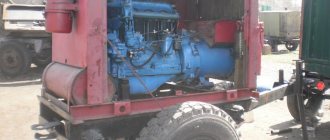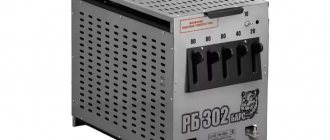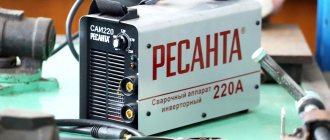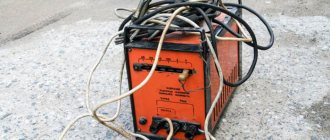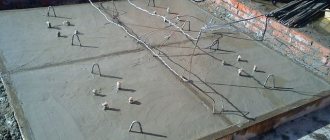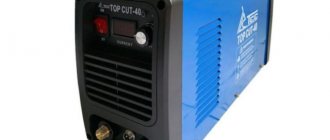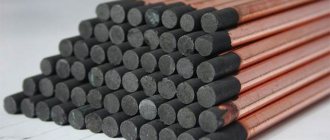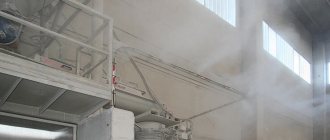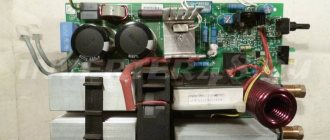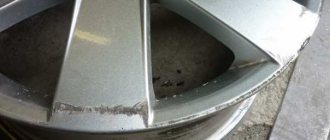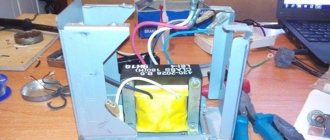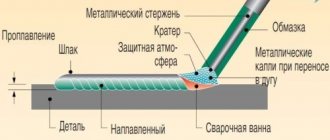Welding machines are actively used for both industrial and domestic purposes. To perform the work, it is necessary to provide this equipment with electricity. To create a high-quality seam, the alternating current received from the network must be converted into the desired form. For this purpose, you need to use a diode bridge for the welding machine. The master must know why this is necessary and how the rectifier unit works.
Schematic diagram of a welding rectifier Source promkomrostov.ru
Energy conversion during welding machine operation
When connected to the network, the current first flows into a step-down transformer. An alternating electromagnetic field will excite a current in the secondary winding with the parameters required for the welding machine. It will have lower voltage and higher current.
It then passes through a rectifier unit, which will ensure that the current has the same polarity. In this case, significant pulsations will remain. To smooth them out, it will be passed through a capacitor unit. After it, the electricity used directly for arc welding will be largely stable in order to create a high-quality and reliable seam.
Scheme of operation of a diode bridge Source promkomrostov.ru
What is a Schottky diode
The Schottky diode belongs to the family of diodes.
It looks almost the same as its brothers, but there are slight differences. A simple diode looks like this in the diagrams:
diode designation on the diagram
A zener diode is already designated as a diode with a “cap”
Zener diode designation in the diagram
The Schottky diode has two “caps”
Schottky diode designation in the diagram
To make it easier to remember, you can add a head and legs and imagine a little man dancing a lambada)
Various types of welding rectifiers
Depending on the model, various schemes may be used for this purpose. The following types of rectifiers are used:
- Operating on the basis of a transformer.
- Built on the use of transistors that provide rectification and smoothing of the current.
- Diode bridges.
- Using a choke, which is designed to contain sudden surges in current and voltage.
- Based on the use of thyristors.
- Inverter converters, which increase the frequency, bring the current and voltage to the parameters required for operation.
The use of a diode bridge is considered one of the most effective methods of obtaining current with the parameters required for operation.
The following video describes how to assemble a diode bridge:
Schottky diode in RF circuits
Schottky diodes also have fast switching speed. This means we can use them in high frequency (RF) circuits.
So, let's take a frequency generator and set the sine frequency to 60 Hz
Let's take a 1N4007 diode and a 1N5817 Schottky diode. Let's connect them using a simple half-wave rectifier circuit
and we will take evidence from them
As you can see, both of them do an excellent job of rectifying the signal at a frequency of 60 Hz.
But what happens if we increase the frequency to 300 kHz?
Wow! The Schottky diode more or less copes with its task, which cannot be said about a simple 1N4007 diode. A simple diode cannot cope with its task of not allowing reverse current to pass through, so we see a negative surge on the oscillogram
From this we can conclude: Schottky diodes are recommended for use in RF circuits.
Video description
How to assemble a diode bridge
There are also other ways to classify welding equipment. The one that is based on the use of various types of characteristics is often used:
- Rectifiers, which are characterized by steep characteristics, are usually used for manual arc welding. They are also used for working with non-consumable electrodes in a special gas environment. Such a device is capable of creating radio interference, which is suppressed by using appropriate filters.
- Devices with rigid characteristics are used to work with electrodes that melt in carbon dioxide.
- Universal devices can be used for all types of welding work.
These devices must be distinguished by the strength of the current used. Power diodes are designed to operate in cases where it is significant. Industrial level welding machines designed for a three-phase voltage of 380 V can operate with a current of up to 400 A. For single-phase it is 125-180 A.
Operating principle of a welding machine circuit Source ice-people.ru
Miniaturization
With the development of microelectronics, special microcircuits and single-chip microprocessors began to be widely used. All this does not exclude the use of hanging elements. However, if radioelements of conventional sizes are used for this purpose, this will negate the whole idea of miniaturization as a whole. Therefore, open-frame elements were developed - SMD components, which are 10 or more times smaller than conventional parts. The current-voltage characteristics of such components are no different from the current-voltage characteristics of conventional devices, and their reduced dimensions make it possible to use such spare parts in various microassemblies.
SMD components come in several sizes. SMD size 1206 is suitable for manual soldering. They have a size of 3.2 by 1.6 mm, which allows you to solder them yourself. Other SMD elements are more miniature, assembled at the factory with special equipment, and it is impossible to solder them yourself at home.
The operating principle of an smd component is also no different from its large counterpart, and if, for example, we consider the current-voltage characteristic of a diode, then it will be equally suitable for semiconductors of any size. The current range is from 1 to 10 amperes. The markings on the case often consist of a digital code, the decoding of which is given in special tables. They can be tested for suitability using a tester, just like their larger counterparts.
Pros and cons of using a diode bridge
In some devices, instead of using a diode bridge for a welding machine, a transformer is included in the design. The latter method provides lower quality work. A circuit with a diode bridge allows you to take advantage of the following advantages:
- With its help, the electric arc becomes more stable.
- Current rectification contributes to more economical energy consumption during operation.
- Relatively high efficiency.
- The rectifier not only converts current, but also stabilizes voltage. It allows the welding machine to operate reliably even in cases where the power grid is unstable.
- The amount of spatter is reduced during welding.
- Compared to using a transformer when using a diode bridge, the device has less weight and more compact dimensions.
- Carrying out welding work ensures higher reliability of the connection.
Welding rectifier disassembled Source ice-people.ru
However, the use of diode bridges also has the following disadvantages:
- The parameters of energy coming from the electrical network play an important role. The use of diode bridges puts forward certain stability requirements.
- Higher quality of work is associated with a small loss of power.
- Higher risk of short circuit.
- The use of this method causes an increase in the cost of equipment.
The use of diode bridges for rectification ensures higher welding quality.
The master must constantly monitor the performance of the device Source radioelementy.ru
Reverse leakage current
But since Schottky diodes are so cool, why not use them everywhere? Why do we still use simple diodes?
If we connect the diode in the opposite direction, it will block the passage of electric current. This is true, but not entirely. Very little current will still flow through the diode. In some cases this is not taken into account. This small current is called reverse leakage current . In English it sounds like reverse leakage current .
It is very small, but it exists.
Let's do a simple experiment. Let's take a laboratory power supply, set it to 19 V and apply this voltage to the diode in the opposite direction
We measure the leakage current
diode reverse leakage current
As you can see, its value is 0.1 µA.
Let's now repeat the same experiment with a Schottky diode
Schottky diode reverse leakage current
Wow, almost 20 µA already! Well, yes, in some cases these are mere pennies and can be ignored. But there are circuits where such a small current is still unacceptable. For example, in peak detector circuits
peak detector circuit
In this case, these 20 µA will be quite significant.
But there is also another stumbling block. As the temperature increases, the reverse leakage current increases significantly!
dependence of the reverse leakage current on the body temperature of the Schottky diode
Therefore, you cannot use Schottky everywhere in the circuits.
But that's not all. The reverse voltage for Schottky diodes is several times less than for simple rectifier diodes. This can also be seen from the datasheet. If the reverse voltage is 1000V for the 1N4007 diode
Then for a 1N5817 Schottky diode this reverse voltage will already be only 20 V
Therefore, if this voltage exceeds the value described in the datasheet, we will end up with:
How to get the current needed for work
The power supply for the welding machine must meet the requirements of the specific model. There are 2 options:
- Single-phase voltage 220 V. It is often used to operate household welding devices. It provides a less uniform current compared to three-phase.
- Three-phase voltage 380 V. This option is often used when carrying out industrial welding. It is available for domestic purposes, provided that the owner can provide this opportunity. Such devices operate more stably and efficiently.
The frequency in both cases is 50 Hz.
The current regulator for welding is described in the video below.
Notes on tables
1. The values of forward voltage drops are given for a junction temperature of 25°C, maximum values (typical - 50...80 mV less), indicating the current in amperes. The TKN of forward voltages at low currents is always negative, but at high currents it can often become positive, especially for diodes with UR > 40...60 V.
2. The values of reverse currents (IR) are given as standard, in milliamps.
3. IFSM - the value of a single shock current in the form of one half-cycle of frequency 50 Hz, amplitude value.
4. Diode capacitance is a nonlinear quantity, given here in picofarads at a reverse voltage of 4 V. It allows you to estimate the order of dynamic switching losses (more precisely, switching charge) in most application circuits.
5. “VAC” is a conditional parameter. Qualitatively describes the behavior of the diode at high currents. “R” is resistive in nature, “R+” is resistive with a noticeable positive TKN, “D” is “diode” (the influence of the parallel pn junction diode is strongly pronounced), “D-” is diode with a pronounced negative TKN, “DеR” is something average.
6. Dual diodes are marked with an asterisk (“*”).
Video description
CURRENT regulator for welding machine.
A voltage is supplied from the network, which varies according to a sinusoid. It cyclically becomes positive and negative. Entering the primary shell of the transformer, constant changes in current create an alternating electromagnetic field, which excites periodic fluctuations in voltage and current in the secondary winding. The difference is that at the transformer output the power consumption is reduced.
Then the current passes through the diode bridge. Since the input voltage varies according to a sinusoid, positive and negative pulses are received at the input, which alternate with each other. After passing through the diode bridge in the welding machine, the former remain unchanged, and instead of the latter, positive ones pass through, having the same amplitude. Thus, a strongly pulsating voltage of the same sign appears at the output.
In order to smooth out the pulsation, a capacitor unit is used for further processing. Its output produces a constant voltage with a high level of stability.
Diagram and view of a diode bridge consisting of 4 diodes Source radioelementy.ru
Use in practice
Schottky rectifiers are used in switching power supplies, voltage stabilizers, switching rectifiers. The most demanding current - 10A or more - are voltages of 3.3 and 5 volts. It is in such secondary power circuits that Schottky devices are most often used. To amplify the current values, they are connected together in a circuit with a common anode or cathode. If each of the dual diodes is rated at 10 amperes, you will get a significant safety margin.
One of the most common malfunctions of switching power modules is the failure of these same diodes. As a rule, they either completely break through or leak. In both cases, the faulty diode must be replaced, then the power transistors must be checked with a multimeter, and the supply voltage must also be measured.
How to choose
The most popular type of factory-made diode bridge is VD306. It is convenient in that it is equipped with the ability to perform smooth adjustments. It should be taken into account that during operation it consumes 12 kW of electricity. The weight of this device reaches 100 kg. This device is most convenient to use for industrial welding.
You can make a diode bridge with your own hands. It is made from power diodes. There can be from two to five of them in the scheme. A self-made diode bridge will cost less, but to create it, a specialist must have a professional understanding of the equipment.
A welding machine designed for three-phase voltage 380 V has the best performance characteristics. However, there is not always an appropriate power supply network available at the place of work. For example, if you need to carry out welding on a summer cottage, it is unlikely that you will be able to provide it with energy.
Such devices are heavier than those that use a single-phase network. The weight of the latter is in the range of 30-80 kg.
For reliable operation of a diode bridge, it is necessary that the voltage and current values used for which it is designed exceed the actual ones by 1.5-2 times. The maximum reverse voltage of the diodes used should be twice as high as that provided by the transformer. Powerful diodes for a welding machine are necessary for trouble-free operation.
Description of the operation of the diode bridge Source radioelementy.ru
Schottky diode reverse voltage
So, as you remember, a diode allows electric current to pass in only one direction, and in the other direction it blocks the passage of electric current to some critical value, called diode reverse voltage .
This value can be found in the datasheet
diode reverse voltage
It is different for each brand of diode
If this value is exceeded, a breakdown will occur and the diode will fail.
Safety instructions for use
Many types of welding diodes cannot work fully if there is excessive dust. Therefore, they need to be blown out before use. One of the most convenient means for this is using a household hair dryer. With its help, you can not only eliminate dust, but also remove moisture, which affects the electrical characteristics of the equipment. This purge must be carried out at least once a quarter.
Diode bridge for a welding machine Source prosvarku.info
If the welding machine has not been used for a year, it must be warmed up before use. To do this, the device is given the opportunity to work a little in all available modes. The time during which this preparation is carried out must be at least two hours.
During operation, the welding machine consumes a large amount of energy. It is important to ensure that it does not overheat. If its temperature exceeds the permissible level, you need to take a break from work.
It is necessary to check the presence of insulation on all conductive parts. If it is broken, it must be restored. The terminal connections must be secure. During operation, the welding machine must be grounded. If it overheats, one of the following may be the cause:
- There is a short circuit in the transformer winding.
- The cooling fan is not working at full speed.
- The core insulation is broken.
- Due to a malfunction in the secondary circuit of the transformer, the operating voltage is reduced.
If any malfunctions are found, they must be corrected before you start using the welding machine.
Repair of a welding rectifier Source kedrweld.ru
What types of devices are used in welding equipment?
The segment of elements for process equipment - welding power diodes is presented in a variety of options that have unique characteristics and fundamental values for performing the action. Below we provide a detailed specification of diodes for welding equipment.
| Name | Purpose |
| LEDs | A special semiconductor that forms conditional optical radiation in the circuit during the passage of an effective electric current. |
| Rectifier | Internally, these components do not have any resistance (internal view). The amount of resistance will depend directly on the voltage supplied to the diode. |
| IR diode | Used for equipment in the technological part of welding, which provides for remote control of the operation of welding equipment. |
| Photodiodes | The basic principle of operation and direct operation of the component is to convert the light flux into an electrical type. |
| Zener diode | This option is used for a constant source of current supply. The main functional purpose is threshold, that is, achieving a certain voltage value for the device. There is a subcategory of stabistors, which are designed for low powers and voltages. |
| Varicaps (capacitive diode complexes) | The principle of operation of a diode for a welding inverter is similar to a capacitor device. The principle of the effective part of the work lies in the reverse voltage variant, at which the barrier component of the capacitive characteristics changes. |
| Schottky diodes | These types of diodes are characterized by a low voltage drop and a very high speed, which do not accumulate and do not absorb the main characteristics of drives. In the structural part, such diodes have the form of plates, which are covered with a special high-resistivity epitaxial molding film. The main material and component is a silicon base. Schottky diode components are typically used in switching circuits. |
| Thyristors | Two types and technological states are used - open or closed. For the closed method, low conductivity is acceptable, while for the open method, a high category of semiconductor conductivity is acceptable. The functional significance of the diode bridge of a welding inverter lies in the dynamic mode of constant transition from one state to another, moreover, under the influence of the main signal. |
| Immistors | They have a parallel connection option, which uses two thyristors. This option is used for devices with a variable voltage source. |
The main criterion for all types of diode designs is the current value. According to the system described above, there is a division into the following types of diodes, regardless of the name:
- Low power, with an indicator of up to 3 * 102 ma;
- Average power parameter – 3*102 ma – 10A;
- The maximum value is from 10 Amperes.
